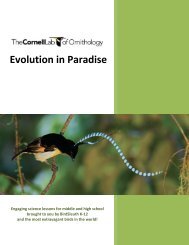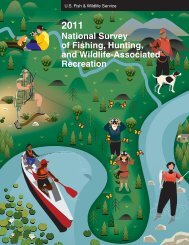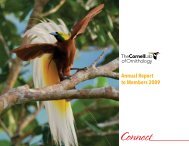AnnuAl RepoRt to membeRs | 2012 - Cornell Lab of Ornithology
AnnuAl RepoRt to membeRs | 2012 - Cornell Lab of Ornithology
AnnuAl RepoRt to membeRs | 2012 - Cornell Lab of Ornithology
You also want an ePaper? Increase the reach of your titles
YUMPU automatically turns print PDFs into web optimized ePapers that Google loves.
From observation <strong>to</strong> impactFinding The MeaningSeeing soundA human being would have <strong>to</strong> devote 12 years <strong>of</strong> 24/7, nons<strong>to</strong>p listening <strong>to</strong>analyze the millions <strong>of</strong> nocturnal flight calls collected by the <strong>Lab</strong>’s au<strong>to</strong>nomousrecording units. And that person would need encyclopedic knowledge <strong>of</strong> nearly24,000 types <strong>of</strong> calls made by 62 species. That’s why <strong>Lab</strong> programmers are creatingau<strong>to</strong>mated detection s<strong>of</strong>tware that uses artificial intelligence <strong>to</strong> detect flightcalls, convert them in<strong>to</strong> visual spectrograms for analysis, and identify whichspecies constitute the huge migra<strong>to</strong>ry flocks that fly overhead in the night sky.Mapping MigrationWith millions <strong>of</strong> bird observations from citizen-science projects, <strong>Lab</strong> scientists arenow creating unprecedented, sophisticated maps <strong>of</strong> bird migration. These STEM(Spatio-Temporal Explora<strong>to</strong>ry Model) maps combine eBird data with hundreds<strong>of</strong> environmental variables <strong>to</strong> show the expected occurrence for bird specieseach week <strong>of</strong> the year at more than 130,000 locations across the lower 48 states,revealing new insights about the dynamics <strong>of</strong> North American bird migration.Helping the BirdsGerrit VynSafer spots, and times, for wind turbinesUsing new maps based on eBird data,scientists can identify the migra<strong>to</strong>rycorridors birds rely on for safe passagebetween breeding and winteringgrounds. The <strong>Lab</strong> and The NatureConservancy are helping the NewYork State Energy, Research, and DevelopmentAuthority evaluate placeswhere wind energy developmentshould be avoided. <strong>Lab</strong> researchersare also using ARUs at existing windturbine sites <strong>to</strong> track night flight callsand identify the peak migration timeswhen turbines should be powereddown <strong>to</strong> avoid bird collisions.This STEM probability-<strong>of</strong>occurrencemap for YellowWarbler during fall migrationshows the importance<strong>of</strong> shrub/forested wetlands<strong>to</strong>pover sites in the HudsonValley and along the LakeOntario and Erie shorelines.“And Now for Your Weekend Bird Forecast…”Imagine a day when the local TV news weather segment includes a forecast <strong>of</strong> birdsmigrating through your area. It’s happening <strong>to</strong>day at the <strong>Lab</strong> through a partnershipwith Oregon State University and NOAA <strong>to</strong> produce BirdCast—a weekly report thatuses eBird and STEM maps <strong>to</strong> track the migration in real time and forecast whenand where birds are headed next. Someday BirdCast could be provided <strong>to</strong> meteorologists<strong>to</strong> educate the public about bird migration. And for conservation, BirdCastcould be helpful in advising cities when <strong>to</strong> dim lights on buildings and <strong>to</strong>wers <strong>to</strong>reduce the hundreds <strong>of</strong> millions <strong>of</strong> bird deaths from collisions every year.7






